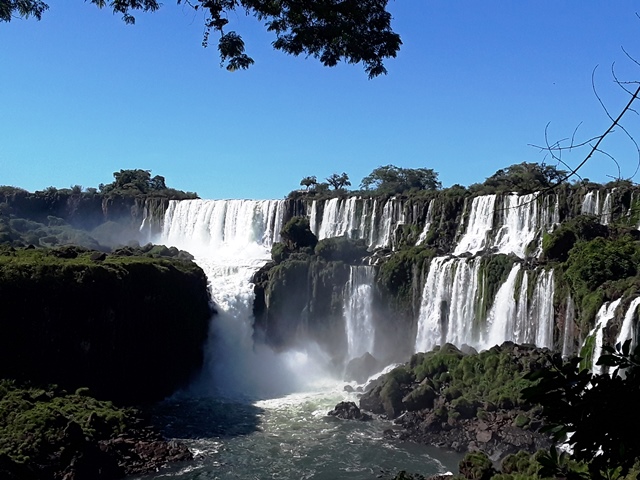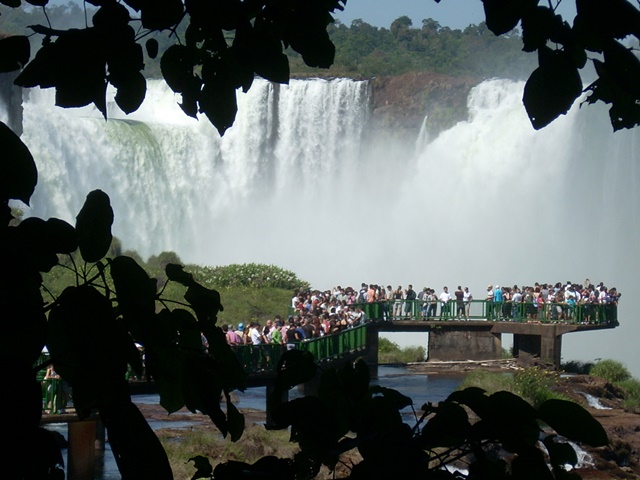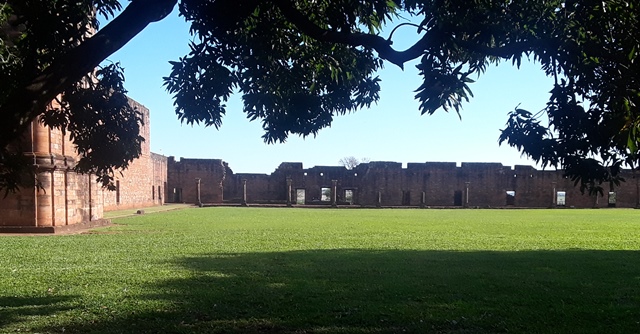Big Water
We ended our long trek through Brazil at one of the Seven Wonders of the Natural World. The Cataracts of Iguazu straddle Brazil’s southern border with Argentina. Of all the borders in South America, this is undoubtedly the most breathtaking.

Anybody who gets within a thousand miles of them should take time to experience Iguazu Falls. Wider than Africa’s famed Victoria Falls and nearly twice the height of Niagara, Iguazu is actually composed of many individual cataracts - 275 to be exact - that plunge over sheer cliffs into a narrow canyon 260 feet below.
When you go, be sure to wear your swim suit because when you approach the thundering water you get drenched with perpetual mist, and love it.
Travelers carry on a perpetual debate about which side of the falls, Brazil or Argentina, offers the best visitor experience. If you choose the Brazilian vantage point, you get unhindered panoramas of the cataracts from the cliff side causeway that runs the length of the canyon. The trek ends at the bottom of the massive Devil’s Throat cataract. Only half the water of the Iguazu River plunges over the Devil’s Throat, yet this is enough to fill two Olympic-size swimming pools every second.

Visitors to Argentina’s Iguazu National Park must walk a country mile from the park entrance to their first glimpse of the falls, but the hike through lush tropical forest is well worth it. Along the way you might see toucans, parrots and others of the 400 bird species that live here. You might also come across iguanas, monkeys or, very occasionally, a giant anteater.
A park animal you will most certainly encounter is the coati, South America’s version of the raccoon. Once scarce and shy, they now roam the trails in menacing herds. Do not feed them, park rangers tell you. Actually, you won’t need to, the coatis feed themselves. They have learned how to poke their pointy noses into bags and backpacks to snatch snacks, and they can pounce on unsuspecting picnickers and gobble up lunch in seconds.

But even these rascals can’t spoil the pleasure of roaming Iguazu’s water wonderland. I have been to the falls probably 7 or 8 times over the years, and every visit is as delightful as the first. For me, one of most unforgettable experiences at Iguazu is to stand on Argentina’s causeway atop the Devil’s Throat, drenched in milky mist thrown up from the falls. The thunderous roar makes conversation impossible and you try not to think about what would happen if you fell into the terrifying torrent. But the tension fades as you notice hundreds of butterflies fluttering around the heads of the spectators and landing on their shoulders.
When you visit Iguazu, plan to spend several days enjoying Argentina’s fascinating province of Misiones, whose inhabitants go by the nickname “misioneros.” That sobriquet translates to “missionaries” in English, which is one reason we feel so much at home here. Why would we not, when surrounded by 1.3 million fellow missionaries, by far the highest concentration of us in the world?
We feel at home in Misiones for other reasons, the most important being the many friends who house and feed us when we visit. Our hosts pamper us with daily barbecues featuring Argentina’s famous beef. They have also taught us to savor Argentina’s national pastime: friendly conversation carried on while sipping yerba mate.
If you have never experienced yerba mate, I will try, and likely fail, to describe this unique beverage. No, that’s not right; yerba mate is more than a beverage. It’s an institution.
The recipe is simple enough. You start with a small gourd or wooden cup, the mate, and fill it two-thirds full with yerba, crushed kiln-dried leaves from a small tree that grows in the red soil of the Southern Cone and, I’m told, nowhere else in the world. Then you insert a strainer-tipped metal straw into the mate and pour hot water over the yerba. Let it soak for a moment, then take a pull.
It’s best not to sip alone. This stuff is made to share. Couples, entire families and groups of friends will usually share the mate, recharging it with hot water after each sip and passing it around the circle several times. According to protocol, you are not to say “gracias” (thank you) until you are finished sipping. In yerba mate culture, this is the polite way to signal to your host that you want no more.
Watching a person take their first sip of yerba mate always reveals the range of human responses to new and unusual flavors. For example, if the sip elicits startled surprise followed by something like, “Wow! That’s potent stuff!”, then this person will probably try the beverage again, and again, until he or she develops a taste for it. Other first-time sippers just stare ahead, deadpan, then wordlessly withdraw the metal straw. This is the noncommittal, let me think this over, response. Observe this person closely to see whether he or she takes a second sip or firmly says “gracias” when it is offered.
Finally, there is the Oh my gosh! What just hit my mouth? reaction, typically accompanied by eyes tight shut and an explosive ejection of the metal straw. This person will under no circumstances accept a second sip. Protocol dictates that he or she should say a polite “gracias” to the host, but invariably it comes out “YUCK!”
To appreciate the vital importance of mate culture, I suggest you take a tour of a yerba processing plant. Our friends took us to a mom-and-pop operation that followed the age-old technique of drying the leaves in a wood-fired kiln and aging them in burlap. This is the process invented by the Guarani, the first inhabitants of the Southern Cone. They shared their secret with the first Europeans to arrive in their part of the world and yerba was on its way to becoming the valuable commodity that it is today.
Those first Europeans were members of the Society of Jesus, popularly known as Jesuits. The Society established the mission of San Ignacio Guazú in present-day Paraguay a full decade before the Mayflower arrived on the coast of Massachusetts. From that base, the Jesuits expanded missionary outreach to territories in Brazil, Argentina and Bolivia. Their considerable influence on Argentina is what inspired the name of the province of Misiones.
By 1750, nearly 200 thousand native Americans were living in Jesuit mission centers spread across the Southern Cone. Called “reductions”, the missions gathered Guarani families into communal settlements to teach them agriculture, literacy, cloth making, carpentry, arts, music and Catholicism. In many of the reductions Jesuit fathers built grand chapels and cathedrals, architectural wonders that still survive and never fail to impress.
Sadly, the missions themselves failed to survive. When Europeans colonists began to populate the region, opposition to the Jesuit missions mounted. Plantation owners coveted the choice land cultivated by Guarani communities. Slave traders resented the Jesuits because they protected the natives from being trafficked.
Influential Spanish and Portuguese colonists lobbied their respective governments to rein in the Jesuits. They falsely claimed that the fathers forced the Guarani into slavery and were amassing huge fortunes from their labor. They said the missionaries employed threats and physical abuse to confine the Guarani to their reductions.
None of these charges were true, but in the end it made no difference. European economics and politics, aided by Vatican jealousy of the Jesuit order, produced the intended effect. Portugal expelled the Jesuits from Brazil in 1759. Eight years later, Spain ordered their expulsion from the rest of the Americas.
If this story sounds vaguely familiar, it could be because you have seen the movie “The Mission.” In the film, Jeremy Irons portrays a pioneering Jesuit missionary and Robert De Niro a repentant slave trader who join forces to defend the Guarani from rapacious European colonists. The effort is doomed to failure, of course.

The plot of The Mission is tragic, but the scenery is stunning. I should mention that the movie won an Oscar for best cinematography. It was filmed at Iguazu Falls, so I guess you could say that they are an Oscar-winning Wonder of the Natural World.
In the mid-twentieth century, history repeated itself when a new wave of missionary outreach spread through indigenous communities in South America. Evangelical Christians working in organizations such as Wycliffe Bible Translators, New Tribes Mission, the Swiss Indian Mission and YWAM began to engage aboriginal tribes, many of whom had little or no contact with the outside world.
In contrast to their counterparts in the era of European colonialism, the new missionaries had not come to “civilize” native Americans or to introduce them to “modern ways” developed by Western cultures. Their purpose was simply to offer them the gospel of Jesus in understandable language in hopes they might want to become his followers.
Sadly, the new missionaries encountered far fewer native Americans than did their colonial counterparts. Since the arrival of Europeans, the indigenous population had suffered huge losses. Researchers estimate that 90 percent of the original Americans, 55 million persons, died of smallpox, measles or influenza after 1492. The inhabitants of Amazon numbered five million then; they are less than 200,000 today. In this century alone, 100 entire tribes have ceased to exist.
The technical term for this is ethnocide, the death of a culture, and it is catastrophic. As happens when a species becomes extinct, the world loses a part of itself. An irreplaceable language disappears. A unique way of life dies.
Like the Jesuits, today’s missionaries to native Americans face determined opposition to their work. Anthropologists, human rights activists and businessmen are among those lobbying for their expulsion. According to their detractors, these missionaries are committing ethnocide in their endeavor to Christianize tribal peoples.
These allegations sound eerily similar to those leveled against the Jesuits 300 years ago. Modern missionaries continue to face charges of enriching themselves through exploitation of slave labor. Some have even been accused of illegally mining gold on isolated tribal lands. Impartial investigations have yet to uncover a shred of evidence to support these claims, nevertheless the popular perception persists that missionaries are bad news for native Americans.
Actually, an impartial look at the facts suggests just the opposite. Tribes that are actively engaged with Christian missionaries are making remarkable comebacks.
For example, the Arabela tribe of Peru numbered only 50 individuals in 1954 and lived in virtual slavery to rubber traders. That year, missionaries arrived and commenced translating the Bible into the Arabela language. The tribe has since rebounded to more than 300 persons.
Wycliffe Bible Translators first contacted Bolivia’s 100 surviving Chacobos in the 1960s. The tribe has since tripled in size. Observers attribute this to the Chacobos’ conscious affirmation of their language and culture, a result that typically arises from the process of Bible translation.
The Paumari of Brazil have also staged a comeback. Numbering just 150 in 1964, the Paumari are more than 600 today, mainly because their acceptance of Christianity countered the menace of alcoholism, a social ailment that speeds cultural disintegration. Later on, their newfound faith prompted them to reject an even deadlier Western vice: cocaine trafficking.
These are but a few of scores of case studies that indicate the positive effect of Christian missions among tribal peoples. Contrary to popular perception, missionary engagement breaks the cycle of ethnocide. Obviously the indigenous person’s beliefs about God and the spiritual world change, but for the most part this does not alter their daily lifestyle. These groups still dress in the same fashion, hunt and fish according to custom, and live in traditional dwellings. Often their cultural self-image is actually strengthened when they understand that a loving Creator made them uniquely as they are and commissioned them as stewards over their ancestral lands.
With all due respect to the critics, this trend sounds like good news to me. You could even say it ranks as a Wonder of the World.
 Thank you for your interest in my blog. It is now a chapter in my new book Southward Bound, The adventure and wonder of road trips through Latin America, available in paperback and Kindle versions on Amazon.com.
Thank you for your interest in my blog. It is now a chapter in my new book Southward Bound, The adventure and wonder of road trips through Latin America, available in paperback and Kindle versions on Amazon.com.
BTW, you can order the paperback book at 30% off the retail price from Ingramspark. Click here to go to the purchase site.
Thank you!
Dave Miller

